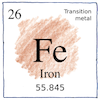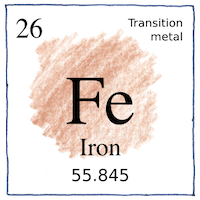Gerzeh
elements

|
Iron
By mass the most common element on Earth, iron is decayed from radioactive nickel produced by fusion in heavy stars before they collapse into supernovas yet native iron is rarely found so that the earliest iron objects are beads from meteoric iron from 3200 BCE or earlier found in a tomb at Gerzeh, Egypt. Obscured by time, the beginning of iron smelting could have been in Eastern Anatolia or West Africa by 1200 BCE, and was well established after 1300 BCE as iron replaced bronze for tools and weapons.
Atomic number 26
The Chinese made cast iron objects in the fifth century BCE. * Steel, an alloy of iron and carbon was produced in Anatolia from 1800 BCE. * Wootz, known as Damascus steel, was produced in India as early as 500 BCE. * The Iron Age followed the Bronze Age. * In the Middle Ages in Europe, from around 500 CE, people made wrought iron from cast iron. * The people of Greenland made tools around 1000 CE using hammered disks made of iron from the Cape York meteorite. * In both China and Europe by 1300, blast furnaces replaced bloomeries. * Modern metallurgy produces iron and steel in greater quantities and with more efficiency than were possible with ancient methods.
Stuff that rusts
Iron can dissolve entirely into rust. Hydrated oxides of iron crack and flake so don’t form a protective layer like the patina on copper. Matthew in the Bible says we shouldn’t put our hopes in things that moths and rust corrupt, and that’s not the only place in the Bible where an understanding of insects and metallurgy is evident. This could be the beginning of a long treatise on stuff that rusts. It would treat the cultural significance of iron beginning with the iron in red blood cells that makes life possible. We are made from rust and to rust we return.



The earth’s magnetic field has been the result of mysterious processes involving electric currents, convection, and cooling of high-pressure iron in the earth’s core.
See also in The book of science:
Readings in wikipedia:
Other readings: